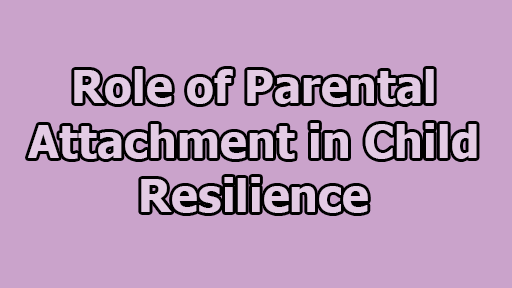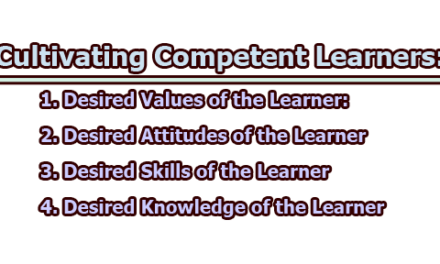Role of Parental Attachment in Child Resilience:
Child resilience is a multifaceted concept that encompasses a child’s ability to adapt, cope, and thrive despite adversity. It is influenced by a myriad of factors, one of the most significant being parental attachment. Parental attachment refers to the emotional bond that develops between a child and their primary caregivers, typically parents or guardians. This bond plays a critical role in shaping a child’s emotional, cognitive, and social development, and ultimately, their ability to navigate life’s challenges. In this article, we will explore the role of parental attachment in child resilience, considering the theoretical foundations, empirical evidence, and practical implications of this crucial connection.
Section 1: Theoretical Foundations of Parental Attachment:
1.1 Attachment Theory: Attachment theory, developed by John Bowlby and later expanded by Mary Ainsworth, provides the foundation for understanding parental attachment and its impact on child resilience. According to this theory, children are biologically predisposed to seek proximity to their primary caregivers, particularly in times of distress. This proximity serves as a secure base from which children can explore the world and return to when they encounter difficulties. Bowlby identified four primary attachment styles: secure, anxious-ambivalent, anxious-avoidant, and disorganized. These styles reflect the quality of the child’s attachment relationship and lay the groundwork for their future resilience.
- Secure Attachment: Children with secure attachments feel confident that their caregivers will be responsive and available when needed. They use the caregiver as a secure base for exploration, leading to the development of positive self-esteem and a belief in their ability to cope with challenges. This forms a strong foundation for resilience.
- Anxious Attachment: Anxious-ambivalent and anxious-avoidant attachments represent insecure attachment styles. Children with these styles may struggle to rely on their caregivers consistently, which can hinder their resilience development. Anxious-ambivalent children may become overly dependent on their caregivers, while anxious-avoidant children may develop a tough exterior to protect themselves from potential neglect.
- Disorganized Attachment: This style reflects extreme instability and unpredictability in the caregiver-child relationship. Children with disorganized attachments often struggle to develop a coherent understanding of their caregivers, leading to significant challenges in developing resilience.
1.2 The Role of Caregiver Sensitivity: Central to attachment theory is the concept of caregiver sensitivity. A sensitive caregiver is one who is attuned to the child’s needs, responsive, and emotionally available. The caregiver’s ability to understand and meet the child’s emotional and physical needs is crucial in fostering a secure attachment. When caregivers respond consistently and appropriately to a child’s cues, it instills a sense of trust and safety, which are essential components of resilience.
Section 2: Parental Attachment and Child Resilience: Empirical Evidence:
2.1 Secure Attachment and Resilience: Research has consistently shown that secure attachment plays a pivotal role in fostering child resilience. Children who have experienced secure attachments tend to exhibit the following traits:
- Emotional Regulation: Securely attached children are better at regulating their emotions. They have learned that their caregivers are dependable sources of comfort, so they are less likely to become overwhelmed by distressing emotions.
- Problem-Solving Skills: The secure base provided by a caregiver allows children to develop problem-solving skills. They are more likely to approach challenges with confidence and a belief that they can overcome them.
- Social Competence: Securely attached children tend to have better social skills. They are more empathetic, understanding, and capable of forming healthy relationships, all of which are important for resilience.
2.2 Insecure Attachment Styles and Resilience:
- Anxious Attachment: Children with anxious-ambivalent or anxious-avoidant attachments may experience difficulties in building resilience. Anxious-ambivalent children may struggle with emotional regulation and may have a higher risk of anxiety disorders. Anxious-avoidant children may develop a facade of self-reliance that hinders their ability to seek help or support when needed.
- Disorganized Attachment: Disorganized attachment is often associated with the highest risk for poor resilience outcomes. Children with disorganized attachments may develop a wide range of behavioral and emotional issues, making it difficult for them to adapt and thrive in challenging situations.
2.3 Long-Term Effects on Resilience: The effects of parental attachment on child resilience are not confined to childhood. They extend into adolescence and adulthood. Several longitudinal studies have demonstrated that children who experienced secure attachments in their early years tend to demonstrate higher levels of resilience across the lifespan. This resilience can manifest in various ways:
- Academic Achievement: Securely attached individuals are more likely to perform well in school, thanks to their enhanced problem-solving skills and emotional regulation. This academic success can be a significant factor in fostering resilience, as it provides a sense of competence and mastery.
- Psychological Well-Being: Securely attached individuals tend to experience lower rates of anxiety, depression, and other mental health issues. The emotional support and sense of security they developed in childhood continue to influence their psychological well-being in adulthood.
- Coping with Stress: Secure attachment contributes to effective stress management. Adults who experienced secure attachments in childhood are better equipped to cope with the challenges and setbacks that life inevitably presents.
Section 3: Practical Implications for Parenting:
3.1 Creating Secure Attachments:
- Responsive Caregiving: Parents and caregivers should respond promptly and consistently to a child’s needs. This responsiveness fosters trust and a sense of security, which are fundamental to a secure attachment.
- Emotional Availability: Caregivers should be emotionally available and attuned to a child’s feelings. This involves active listening and validation of a child’s emotions, even if they don’t understand or agree with them.
- Consistency and Predictability: Maintaining a consistent routine and providing predictability in a child’s life can promote feelings of safety and trust, both essential for secure attachment.
- Sensory Engagement: Physical touch, eye contact, and positive verbal interactions are crucial for nurturing a secure attachment. These sensory experiences reinforce the emotional connection between child and caregiver.
3.2 Interventions for Insecure Attachment: For children with insecure attachments, intervention and support are crucial in promoting resilience:
- Attachment-Based Therapies: Therapeutic interventions, such as attachment-based family therapy, can help children and their caregivers rebuild secure attachments. These therapies focus on enhancing the caregiver’s sensitivity and responsiveness.
- Parenting Programs: Parenting programs that emphasize nurturing, attachment-building practices can be effective in improving the quality of the caregiver-child relationship. These programs often provide education and support to parents and caregivers.
- Early Intervention: Early detection and intervention for children with disorganized attachments can be critical in preventing long-term negative outcomes. Child welfare agencies and mental health professionals should be involved in identifying and addressing these cases.
3.3 Promoting Resilience:
- Encourage Problem-Solving: Parents and caregivers can foster resilience by encouraging children to solve problems on their own when appropriate, while providing guidance and support when necessary. This helps children develop confidence in their abilities.
- Teach Emotional Regulation: Parents can help children develop emotional regulation skills by modeling healthy emotional expression and providing strategies for managing strong emotions.
- Build Social Competence: Encouraging children to develop positive relationships and social skills is essential for resilience. This can be accomplished through opportunities for playdates, group activities, and other social interactions.
- Support Educational Goals: Parents should be actively involved in their child’s education, providing support and guidance to help them succeed academically. Academic achievement is closely linked to resilience.
- Stress Coping Strategies: Teaching children how to cope with stress and adversity is a vital part of resilience-building. This can include mindfulness practices, deep breathing exercises, and problem-solving techniques.
In conclusion, the role of parental attachment in child resilience is a fundamental aspect of child development. Attachment theory provides a framework for understanding how the emotional bonds between children and their caregivers shape their ability to adapt, cope, and thrive in the face of adversity. Empirical evidence supports the notion that secure attachment fosters resilience, while insecure attachments can pose challenges for a child’s ability to navigate life’s difficulties. The practical implications for parenting and interventions highlight the importance of nurturing secure attachments and providing support when attachment is insecure. By fostering secure attachments and promoting resilience, we can better equip children to face life’s challenges with confidence and strength, ultimately leading to positive outcomes throughout their lives.
Frequently Asked Questions [FAQs]:
What is parental attachment, and how does it relate to child resilience?
Parental attachment refers to the emotional bond between children and their primary caregivers, typically parents or guardians. This bond is central to a child’s emotional, cognitive, and social development. Parental attachment plays a critical role in shaping a child’s resilience, as it provides a secure base from which children can navigate life’s challenges.
What are the different attachment styles, and how do they impact child resilience?
Attachment theory identifies four primary attachment styles: secure, anxious-ambivalent, anxious-avoidant, and disorganized. Securely attached children tend to develop better resilience, while insecure attachment styles can hinder a child’s ability to cope with adversity. Anxious-ambivalent and anxious-avoidant children may have difficulties with emotional regulation and problem-solving, while disorganized attachment is associated with extreme instability and unpredictability, posing the highest risk for poor resilience outcomes.
How can parents or caregivers foster secure attachment in their children?
Fostering secure attachment involves being responsive, emotionally available, consistent, and predictable. Caregivers should respond promptly and consistently to a child’s needs, provide emotional support, and create a stable and nurturing environment. Sensory engagement, such as physical touch and eye contact, is also crucial for nurturing secure attachments.
Can insecure attachment be changed or improved, and how can parents or professionals help with this?
Yes, insecure attachment can be improved with interventions. Attachment-based therapies, parenting programs that emphasize nurturing practices, and early interventions can help rebuild secure attachments for children with insecure attachment styles. These interventions focus on enhancing caregiver sensitivity and responsiveness.
What are the long-term effects of parental attachment on child resilience?
The effects of parental attachment on child resilience extend into adolescence and adulthood. Children who experienced secure attachments tend to perform better academically, have better psychological well-being, and cope more effectively with stress throughout their lives. Secure attachment fosters resilience that can positively impact various aspects of an individual’s life.
Are there practical strategies that parents can use to promote resilience in their children?
Yes, parents can promote resilience by encouraging problem-solving skills, teaching emotional regulation, helping children build social competence, supporting their educational goals, and teaching stress coping strategies. These practical strategies can equip children with the tools they need to navigate challenges effectively.
What are the potential signs that a child may be struggling with attachment issues or a lack of resilience?
Signs of attachment issues may include difficulty with trust, difficulty forming healthy relationships, emotional dysregulation, and an inability to seek support when needed. Signs of a lack of resilience may include frequent emotional breakdowns, avoidance of challenges, and difficulty coping with stress or adversity.
Are there resources or professionals who can help parents or caregivers in fostering secure attachment and resilience in children?
Yes, numerous resources and professionals can provide support. These include child psychologists, family therapists, parenting programs, and educational materials designed to help parents and caregivers understand the principles of secure attachment and resilience-building.
References:
- Bowlby, J. (1969). Attachment and Loss: Attachment (Vol. 1). Basic Books.
- Ainsworth, M. D. S., Blehar, M. C., Waters, E., & Wall, S. (1978). Patterns of Attachment: A Psychological Study of the Strange Situation. Lawrence Erlbaum.
- Sroufe, L. A. (2005). Attachment and Development: A Prospective, Longitudinal Study from Birth to Adulthood. Attachment & Human Development, 7(4), 349-367.
- Bretherton, I. (1992). The Origins of Attachment Theory: John Bowlby and Mary Ainsworth. Developmental Psychology, 28(5), 759-775.
- Main, M., & Solomon, J. (1990). Procedures for identifying infants as disorganized/disoriented during the Ainsworth Strange Situation. In M. T. Greenberg, D. Cicchetti, & E. M. Cummings (Eds.), Attachment in the Preschool Years: Theory, Research, and Intervention (pp. 121-160). University of Chicago Press.
- Waters, E., Merrick, S., Treboux, D., Crowell, J., & Albersheim, L. (2000). Attachment security in infancy and early adulthood: A twenty-year longitudinal study. Child Development, 71(3), 684-689.
- Sroufe, L. A., Egeland, B., Carlson, E. A., & Collins, W. A. (2005). The Development of the Person: The Minnesota Study of Risk and Adaptation from Birth to Adulthood. Guilford Press.
- Luthar, S. S., Cicchetti, D., & Becker, B. (2000). The construct of resilience: A critical evaluation and guidelines for future work. Child Development, 71(3), 543-562.
- Masten, A. S. (2001). Ordinary Magic: Resilience Processes in Development. American Psychologist, 56(3), 227-238.
- Spera, C. (2005). A review of the relationship among parenting practices, parenting styles, and adolescent school achievement. Educational Psychology Review, 17(2), 125-146.
- Thompson, R. A. (2008). Early Attachment and Later Development: Familiar Questions, New Answers. In J. Cassidy & P. R. Shaver (Eds.), Handbook of Attachment: Theory, Research, and Clinical Applications (2nd ed., pp. 348-365). Guilford Press.
- Gross, J. T., Stern, J. A., Brett, B. E., & Cassidy, J. (2017). The multifaceted nature of prosocial behavior in children: Links with attachment theory and research. Social Development, 26(3), 661-678.
- Belsky, J., Fearon, R. M. P., & Bell, B. (2007). Parenting, attention, and externalizing problems: Testing mediation longitudinally, repeatedly, and reciprocally. Journal of Child Psychology and Psychiatry, 48(12), 1233-1242.

Former Student at Rajshahi University










